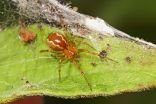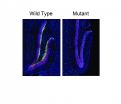(Press-News.org) PROVIDENCE, R.I. [Brown University] — A new study in the Journal of the American Heart Association reports a significant association between living near a major roadway and the risk of high blood pressure.
The Brown University-led analysis of data from 5,400 post-menopausal women in the San Diego metropolitan area found that women who lived within 100 meters of a highway or major arterial road had a 22-percent greater risk of hypertension than women who lived at least 1,000 meters away. In a range of intermediate distances, hypertension risk rose with proximity to the roadways.
Put in epidemiological terms, a 58-year-old woman in the study who lived close to a major road had the blood pressure risk of a 60-year-old woman who lived far from one. The elevated risks reported in the study statistically account for a wide range of confounding cardiovascular risk factors including age, demographics, health, and lifestyle and even local fast food availability.
Hypertension is an underlying factor for some cardiovascular diseases. For that reason, the increased likelihood of hypertension reported in the new study may help explain prior findings of associations between proximity to major roadways and cardiovascular diseases such as stroke. A few studies, mostly in Europe, have also tested the association between roadway proximity and hypertension, but results have been mixed.
"I think in the United States this study does tip the scale in favor of being concerned about the urban environment and how we develop our cities and our transportation systems," said study corresponding author Gregory Wellenius, assistant professor of epidemiology in the Brown University School of Public Health. "There are a lot of new developments going up right near highways. One has to start thinking about what are the associated health effects with that."
Assessing the association
The study data comes from the Women's Health Initiative, a study funded by the National Heart Lung and Blood Institute that enrolled tens of thousands of participants in the mid 1990s including more than 5,600 in San Diego County. The study gathered data on a wide variety of personal health and demographic measures, including where participating women lived, their blood pressure and other key attributes.
Wellenius, lead author and graduate student Kipruto Kirwa, and their co-authors took this dataset and used mapping software to measure the distance from each woman's home to a major roadway. They also consulted a database to determine each neighborhood's abundance of supermarkets and fast-food restaurants to determine who lived in a so-called "food desert" where unhealthy food options were relatively many and healthier ones relatively few.
They then looked at the association between the prevalence of high blood pressure and distance from the highway (in ranges of less than or exactly 100 meters, between 100 and 200 meters, 200 to 1,000 meters and more than 1,000 meters).
In three levels of analysis, the researchers controlled for more and more possible confounding factors. In all, they controlled for age, ethnicity, smoking status, education, household income, cholesterol, body-mass index, diabetes history, physical activity level, and local food quality.
After all that, they found the odds of hypertension were 1.22 to 1 for those living closest, 1.13 to 1 for those between 100 and 200 meters, and 1.05 to 1 for those between 200 and 1000 meters from a major roadway. These odds are indexed such that 1 represents the prevalence risk of those living more than 1,000 meters from a major roadway.
Wellenius acknowledged that because the study only measured who had hypertension and where they lived at one moment in time, it does not necessarily show a causal link. The study also does not shed light on what specifically about proximity to the road could cause hypertension. It could be airborne pollutants or noise or both — or something else. But prior studies have shown specific physiological effects from pollution and noise that could have direct causal relevance to cardiovascular disease.
Wellenius cautioned that hypertension, even when treated, still carries an elevated risk of cardiovascular disease. The best policy, he said, is therefore prevention.
"The public health message is that we need to take into consideration the health of the population when planning neighborhoods, when planning transportation systems, and when deciding where new highways are going to go, and how we might be able to mitigate traffic or its effects," Wellenius said.
INFORMATION:
In addition to Kirwa and Wellenius, other authors are Melissa Eliot, Yi Wang, and Dr. Charles Eaton of Brown; Marc Adams of Arizona State University; and Cindy Morgan, Jacqueline Kerr, Gregory Norman, and Dr. Matthew Allison of the University of California–San Diego.
Grants from the National Institute of Environmental Health Sciences (R01-ES020871 and R00-ES015774), from the National Cancer Institute (R21-CA127777), and the National Institutes of Health (NO1-WH-3-2120) and Brown University funded the study. END
Hypertension risk rises closer to major roadways
2014-10-01
ELSE PRESS RELEASES FROM THIS DATE:
Hospitals with aggressive treatment styles had lower failure-to-rescue rates
2014-10-01
Hospitals with aggressive treatment styles, also known as high hospital care intensity (HCI), had lower rates of patients dying from a major complication (failure to rescue) but longer hospitalizations, writes Kyle H. Sheetz, M.D., M.S., of the Center for Healthcare Outcomes and Policy, Ann Arbor, Mich., and colleagues.
The intensity of medical care varies around the country. Intensity is synonymous with an aggressive treatment style and it has been implicated in rising health care costs, especially during the end-of-life period. Inpatient surgery also is a cost burden. ...
Montmorency tart cherry juice lowered blood uric acid levels and a marker for inflammation
2014-10-01
LANSING, Mich. October 1, 2014 – Tart cherries have long been researched for their association with pain relief – ranging from gout and arthritis joint pain to exercise-related muscle pain. A new study published in the Journal of Functional Foods is the first to report consumption of Montmorency tart cherries caused changes in uric acid metabolism, which can have an impact on joint pain. The study also detected increases in specific anthocyanin compounds in the bloodstream after consuming tart cherries.
In the study, Montmorency tart cherry juice reduced blood levels ...
UMN research pinpoints microRNA tied to colon cancer tumor growth
2014-10-01
MINNEAPOLIS/ST PAUL (October 1, 2014) – Researchers at the University of Minnesota have identified microRNAs that may cause colon polyps from turning cancerous. The finding could help physicians provide more specialized, and earlier, treatment before colon cancer develops.
The findings are published today in The Journal of Pathology.
The American Cancer Society estimates over 134,000 people will be diagnosed with colon cancer in 2014, despite the expanded screening processes now available. This year alone, about 50,000 people will die because of the disease.
Research ...
Fibromyalgia and the role of brain connectivity in pain inhibition
2014-10-01
New Rochelle, NY, October 1, 2014—The cause of fibromyalgia, a chronic pain syndrome is not known. However, the results of a new study that compares brain activity in individuals with and without fibromyalgia indicate that decreased connectivity between pain-related and sensorimotor brain areas could contribute to deficient pain regulation in fibromyalgia, according to an article published in Brain Connectivity, a peer-reviewed journal from Mary Ann Liebert, Inc., publishers. The article is available free on the Brain Connectivity website at http://online.liebertpub.com/doi/full/10.1089/brain.2014.0274 ...
Spiders: Survival of the fittest group
2014-10-01
Along rivers in Tennessee and Georgia, scientists have been studying brownish-orange spiders, called Anelosimus studiosus, that make cobwebby nests "anywhere from the size of a golf ball to the size of a Volkswagen Beetle," researcher Jonathan Pruitt says. The individual spiders are only the size of a pencil eraser, but they form organized groups that can catch prey ranging from fruit flies to small vertebrates. "We have found carcasses of rats and birds inside their colonies," Pruitt says. Unlike most spiders, which are solitary, these social spiders work together in groups.
Now ...
New molecule fights oxidative stress; May lead to therapies for cancer and Alzheimer's
2014-10-01
COLUMBIA, Mo. – Breathing oxygen helps the body create energy for its cells. As a result of the breathing process, reactive molecules called "free radicals" are produced that often cause damage to proteins and genes found in cells. This damage is known as oxidative stress. Free radicals also have been linked to cancer, Alzheimer's and Parkinson's disease. Now, investigators at the University of Missouri have discovered a molecule that treats oxidative stress.
"Oxidative stress can cause damage to the building blocks of a cell, resulting in excessive cell proliferation, ...
Decreased ability to identify odors can predict death
2014-10-01
For older adults, being unable to identify scents is a strong predictor of death within five years, according to a study published October 1, 2014, in the journal PLOS ONE. Thirty-nine percent of study subjects who failed a simple smelling test died during that period, compared to 19 percent of those with moderate smell loss and just 10 percent of those with a healthy sense of smell.
The hazards of smell loss were "strikingly robust," the researchers note, above and beyond most chronic diseases. Olfactory dysfunction was better at predicting mortality than a diagnosis ...
AAO-HNSF clinical practice guideline: Tinnitus
2014-10-01
ALEXANDRIA, VA — The American Academy of Otolaryngology—Head and Neck Surgery Foundation has released the first ever mutli-disciplinary, evidence-based clinical practice guideline to improve the diagnosis and management of tinnitus, the perception of sound—often ringing—without an external sound source. The guideline was published today in the journal Otolaryngology–Head and Neck Surgery.
"Tinnitus affects 10-15% of adults in the United States. It is the most common service-related disability among our military veterans. Yet despite its prevalence and effect on quality ...
Decreased ability to identify odors may predict 5-year mortality
2014-10-01
For older adults, being unable to identify scents may be a predictor of mortality within five years, according to a study published October 1, 2014, in the journal PLOS ONE by Jayant Pinto from The University of Chicago and colleagues.
The study was part of the National Social Life, Health and Aging Project (NSHAP), the first in-home study of social relationships and health in a large, nationally representative sample of men and women ages 57 to 85. Researchers first surveyed 3,000 participants in 2005-06, assessing their ability to identify five distinct common odors, ...
Drug treats inherited form of intellectual disability in mice
2014-10-01
Studying mice with a genetic change similar to what is found in Kabuki syndrome, a inherited disease of humans, Johns Hopkins researchers report they have used an anticancer drug to "open up" DNA and improve mental function.
Along with a potential treatment for the intellectual disability seen in Kabuki syndrome, the study's findings also suggest a new way of thinking about a category of genetic diseases known as Mendelian disorders of the epigenetic machinery, the researchers say. In these disorders, a genetic mutation causes errors in the way proteins and chemicals ...






